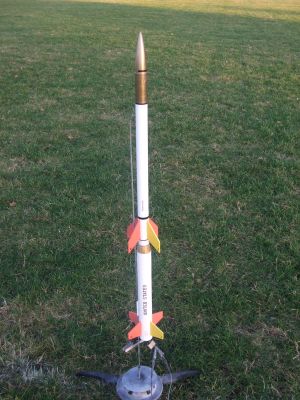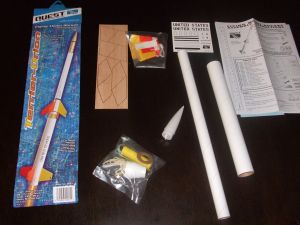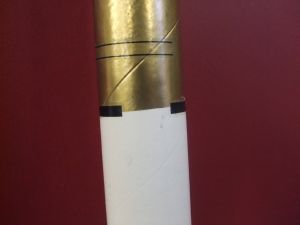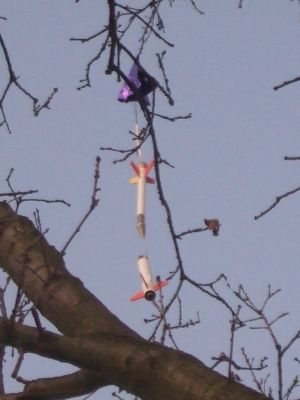| Construction Rating: | starstarstarstar_borderstar_border |
| Flight Rating: | starstarstarstarstar_border |
| Overall Rating: | starstarstarstarstar_border |
| Diameter: | 1.38 inches |
| Length: | 30.10 inches |
| Manufacturer: | Quest  |
| Skill Level: | 2 |
| Style: | Scale |

Brief:
This is a rocket with a double set of four fins and 18mm motor. I got it as a free rocket from EMRR’s rocket
video competition. It came in a clear bag with the usual art card.
Construction:
Kit consists of:
- 1 launch lug
- 1 length elastic shock cord
- 1 length of Kevlar® cord
- 14 inch parachute.
- Nose cone
- Plastic transition
- 2 Body tubes
- Engine motor mount
- Engine block
- Pre cut balsa fins
- Motor clip
- Decal sheet

To build the kit I used:
- Model knife
- Razor saw
- Aluminum oxide sand paper
- White PVA glue
- Bostick glue
- Sanding sealer
- Enamel spray paint
- Enamel brush paint
I was impressed with the quality of the kit. The balsa fins were laser cut and the balsa was good quality. The body tubes were strong. Kevlar® cord supplied as standard. (Why won’t Estes take a leaf out of Quest’s book and supply Kevlar®?) One new change from the kits I have had from Quest in the past is that the motor tube comes with a slot pre-cut for the motor clip.
On the negative side, one of the tubes was slightly oval and something that has to be an oversight on Quests part; the shock cord is far too short. The overall length was 4 feet, but as it is fixed to the motor mount and the nose cone, therefore has to pass through the length of the 30 inch rocket. There needs to be at least 2 foot more added to the cord.
The instructions are clear and straightforward, and the rocket builds quickly. With the exception of the two sets of fins, the build was not much more advanced than a level one rocket, but with the two sets of fins, level two is about right.
Also nose weight needs to be added so you need a razor saw to cut out access to the nose cone. A two part nose cone would have been better.

Finishing:
I sealed the balsa fins as the body tubes had some deep spirals in them.
Then the rocket was sprayed white. Two coats were needed. The tip of the rocket was sprayed gold as was the transition. The fins were hand painted with enamel paint.
The decals provided were the waterslide variety and were undersized. The strips that wrap around the BT were far too short. This ruined the look of the rocket. With the short shock cord and poor decals, I can only give the rocket a 3 out of 5 on the EMRR scale.
Construction Rating: 3 out of 5

Flight and Recovery:
Flies on B6-4 or C6-3 and C6-5
I used 2 sheets of Nomex® wadding and a 10-inch Mylar chute-–I don't like Quest's chutes and 10 inch seemed to be about right as my rockets always manage to drift into trees, so I under-parachuted the rocket.
First flight was on a B6-4. Launch was straight. Anything below a B and this rocket would have struggled to gain height. Ejection was just past apogee and the rocket recovered fine on the 10 inch chute.
Second flight mirrored the first, almost exactly.
The third flight was on a C6-5. The flight was considerably higher and with a squirrelly path. With next to no wind, the Terrier Orion drifted into the top branch of a tree.
Flight Rating: 4 out of 5
Overall Rating: 4 out of 5
Other Reviews
- Quest Terrier-Orion By Brian Ray (March 4, 2008)
Brief: Scale model of the Terrier-Orion, a two-stage payload carrying rocket. This kit features 8 fins, BT-55 and BT-50 body tubes, plastic parachute, and adhesive decals. The kit is flown as a single stage. Construction: Die-cut balsa fins Kevlar ® cord and shock cord materials 11” BT-55 body tube 16” BT-50 body tube PNC-50 nose cone ...
- Quest Terrier-Orion By Todd Mullin (February 18, 2008)
Brief: The Quest Terrier-Orion is a single stage, parachute recovery, sport scale version of the two stage sounding rocket. Quest rates this as a level 2 kit. Construction: All of the components for the kit came in a sealed plastic bag with a hang tab and full color face card. All the components were present and in good condition. In the bag were: 1 10-7/8" T35 ...
 |
 |
Flights
 |
 |
 |
 |
G.B. (May 29, 2009)